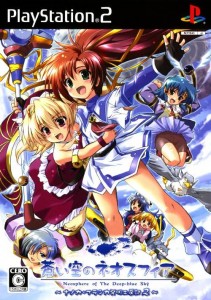 I like item crafting games, the more full-bodied, the better. RPGs with crafting are a dime a dozen, but Gust pretty much has the market cornered on “Here, make items for 40 hours” games. I love Gust and all, but it’s nice to see takes on the genre (if you can call it that) from other companies.
I like item crafting games, the more full-bodied, the better. RPGs with crafting are a dime a dozen, but Gust pretty much has the market cornered on “Here, make items for 40 hours” games. I love Gust and all, but it’s nice to see takes on the genre (if you can call it that) from other companies.
Which brings me to Aoi Sora no Neopshere: Nanoca Flanca no Hatsumei Koubouki 2, known in English as Neopshere of the Deep-Blue Sky. Developed by Kogado Software, Kumasan Team and Nippon Ichi Software, Neosphere came out in 2007 as the sequel to Aoi Umi no Tristia, the first game starring Nanoca Flanka and her team.
I tried to play Tristia about 4 or 5 years ago, but the hour-long save-free prologue turned me off entirely. This time the prologue has been divorced from the beginning of the game, meaning you can dive straight into the game and pick up the story as you go. Since I am somewhat enjoying Neosphere, I might go back and play Tristia one day.
So, who is Nanoca Flanka and why do we care about her? She’s the red-haired loli on the cover. That’s probably all some fans needed to see to pick up the game, but we have higher standards than that. Nanoca is the genius alchemist granddaughter of the genius alchemist Prospero Flanka. She has been sent to the floating land of Neosphere to help them recover after a world war. When she gets there, she finds herself caught up in a power struggle between the loli queen and the not-loli-at-all Council of Elders. No points for picking which faction she sides with. Now Nanoca has to rebuild Neosphere with her alchemy while sidestepping political interference and helping put the Council in their place for good.
I’ll come right out and say that the story is pretty decent. Especially for a game with a cover like that. The writers clearly put a lot of effort into world-building, and they’re not shy about spending 10 minutes explaining how E-technology works or how the political system of Neosphere runs, what challenges the world is facing, the current state of international relations, and on and on and on. At the same time they’re self-aware enough to realize that the majority of their fans came for the lolis. Quite a lot of time of screen-time is devoted to Nanoca’s relations with her loli friends and other companions.
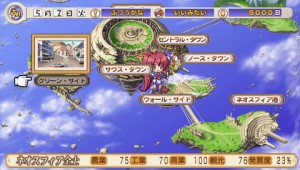 There’s nothing wrong with knowing and catering to your audience. The problem comes when guests like me, who thought they were coming to an alchemy party, find themselves left out in the cold while all this world-building and relationship-development goes on. It’s all but impossible to go through a single in-game week without being interrupted several times by knocks on your door, even when you’re in the middle of a recipe. You step out to do a bit of selling and shopping and bam, 15-minute cutscene – no choices, no skipping, no fast-forwarding. When I do get to do research and alchemy it’s a lot of fun, but those moments are few and far between.
There’s nothing wrong with knowing and catering to your audience. The problem comes when guests like me, who thought they were coming to an alchemy party, find themselves left out in the cold while all this world-building and relationship-development goes on. It’s all but impossible to go through a single in-game week without being interrupted several times by knocks on your door, even when you’re in the middle of a recipe. You step out to do a bit of selling and shopping and bam, 15-minute cutscene – no choices, no skipping, no fast-forwarding. When I do get to do research and alchemy it’s a lot of fun, but those moments are few and far between.
The rebuilding of Neosphere itself is a pretty simple process. First Nanoca creates an item. Then she sells it to one of the heads of the 10 or so towns in Neosphere. She pockets the money and uses it to develop more stuff. The head of the town distributes it to the merchants, they start selling it, business picks up and the town becomes more lively. And on and on it goes.
The catch is that the boost each item gives to a town is temporary. Depending on the item, it won’t affect all the stores either. For example, if you sell cheese to a town, it gives a temporary boost in popularity to the food-related industries. This boost goes away after a couple of days, and you can’t sell the same item to the same town more than once. Long story short, you have to pace your selling activities. Even if you’ve made cheese and coffee and sausages, don’t sell them all at once. Sell the cheese, wait a few days, sell the coffee, wait a bit, sell the sausages. At the same time you don’t want to wait too long, because the town had an allotted budget that is renewed at the end of every month. If Central Town has 10,000 to spend on goods in June, it’s a waste to sell them only 5,000 – though with the way the game works, Nanoca really doesn’t need that much money.
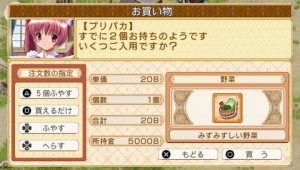 Alchemy itself (strictly speaking Nanoca is a craftsman, not an alchemist but work with me here) is simpler but more time-consuming than in similar games. While Nanoca will occasionally come up with a recipe on her own, for the most part you have to get recipes by researching items. Research milk, learn to make cheese. Research a virus, learn to make a vaccine. Research stone, learn to make cement, research that cement and you learn to make concrete.
Alchemy itself (strictly speaking Nanoca is a craftsman, not an alchemist but work with me here) is simpler but more time-consuming than in similar games. While Nanoca will occasionally come up with a recipe on her own, for the most part you have to get recipes by researching items. Research milk, learn to make cheese. Research a virus, learn to make a vaccine. Research stone, learn to make cement, research that cement and you learn to make concrete.
You develop the country by having Nanoca sell these to the towns, and you progress the story by having her fulfill the two or three special requests people give her every month. It’s simple enough, but both research and synthesis can take ages, even for the simplest of items, not counting all the interruptions. There’s a lot I still want to make, but I don’t know if I’ll have the time to do all of it before the game ends.
That said, I’m only three ‘months’ into the game. It’s August and the game ends in May the following year, so I still have time to catch up. What I really need is to ignore all the town building for a whole month and stockpile a ton of goods to sell at the end of the month. I also need to focus researching and making story-related goods where possible, or I can see myself getting stuck before too long. Much as I’m enjoying this game, the unskippable cutscenes make it highly unlikely that I’ll ever replay it, so I’m going to get the best ending I can this time. More updates when I have more to say.

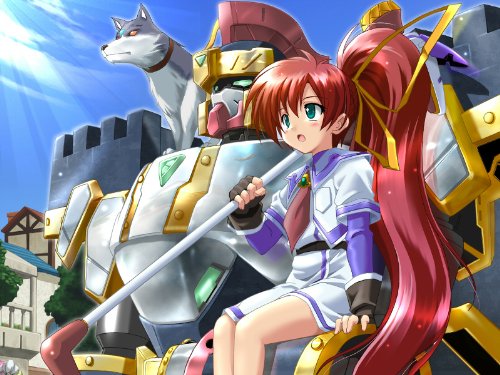
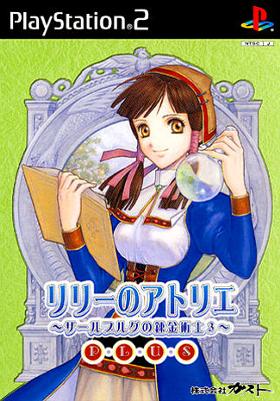
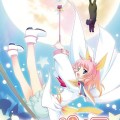
This is my favourite Atelier “clone” (though are there really that many?), although I’m not sure why. Objectively the gameplay’s definitely worse than… I dunno, let’s say Marie? Or is that aiming too high?
It’s probably the world building. The game world is pretty unique IMO.
Nanoca’s one of my favourite Atelier-type heroines, but it’s probably bias because she has a giant robot.
The super strict time limit for forced requests is definitely kind of a thing with this game and I think a really common criticism even amongst its fans.
Isn’t there a fast-forward text feature if you hit R + O or R + Start or something? I definitely utilized it when playing the game because I played the original PC version first and the PSP version was my “replay” and I do remember skipping the text.
As far as the original Tristia goes… uh, Neosphere made one big change which is a huge”quality of life” issue for me: in Neosphere, you sell items to Districts while in Tristia, you sold them to INDIVIDUAL SHOPS, which is a complete nightmare to keep track of.
Anyway, I’m still waiting for a revival of this series one day, even though it’ll probably never happen. They made a bunch of spinoffs that takes place in the same game world but never went back to Atelier cloning. Heck the last one was a Visual Novel and that was in 2010.
Maybe I’m just holding on to hope because the Atelier series seems extra popular nowadays.
I don’t find the time limits all that strict. I usually keep a save a few days back so I can nip back and start preparing to make an item if I realize I don’t have enough time. I also drink lots of coffee and do lots of research in my spare time. It’s working out pretty well.
I haven’t played the PC or the PSP version, but the PS2 version doesn’t have a fast-forward option. The scenes do go by reasonably fast if you put the messages on the fastest speed and mash O, but the scenes themselves are just so long! The dolphin race honestly gave me a headache.
I read up on the two ‘sequels’ done by Cyberfront, and they’re horrible. Not even worth trying, and I’m usually game for anything. I’m going to guess either the re-releases didn’t do that well or there are rights or other issues that prevent a proper sequel from ever coming out.
Well, it’s not really that the time limits are super challenging or anything, just that you’re almost constantly having to do something for someone rather than having “free time” to further research/dev on your own initiative. And it’s not like Atelier where you can just tell your friends to screw off if you don’t feel like making 5 crystals or whatever for them.
Wow, for some reason I didn’t take into account that someone might be playing the PS2 version. I still think it’s strange the game wouldn’t have a skip text feature though… that’s almost a required feature with “VN style” storytelling.
I actually liked “Shirogane no Cal to Soukuu no Joou”, it’s like Snatcher, if you changed 3/4 of the characters’s gender to girls. It’s designed in an ancient, old school fashion following old Japanese adventure games though (where you had to exhaust every option until you triggered the flag for the story to advance), and most people I find can’t stand trying to play those if they didn’t grow up with it.
Akatsuki no Amaneka to Aoi Kyojin is the worst RTS I have ever played in my life though.
I don’t think there’s any issues with rights or anything with this series: Kogado has a “gimmick” Twitter account where the “account owner” is Nanoca and they use it to hawk stuff or just make “cutesy” commentary.
It’s probably just cost-efficiency, as in “not profitable enough to create a Atelier gameplay clone rather than just a normal VN, which we aren’t also aren’t making much of anyway.”
I guess it’s the bad choice of trying to be a “normal” game developer on the PC when everyone else on it has moved to pr0n in Japan, or maybe Touhou. (Falcom used to do it, jumped ship to consoles. KOEI… is technically still making Japanese PC games, but they’re obviously earning their money from milking console Dynasty Warriors games rather than their Historical strategy games)
I checked and rechecked the controls today, but there’s no scene skip or fast-forward for the PS2 version.
I also checked up on Kogado and Cyberfront’s most recent games, and it looks like they’ve both moved completely away from item crafting games. The lukewarm reviews the re-release of Little Witch Parfait received probably didn’t help.
Ah well, it was nice while it lasted.
On a somewhat unrelated note, it seems Neverland Company, aka. developer of Lufia and Rune Factory just went bankrupt. Seems like they’ve been in debt for quite awhile already. That’s another series with emphasis on crafting down the drain… 🙁
Wow, that’s a surprise. I’m really sorry to see them go. I was always under the impression the RF games were a major cash cow. Although since they’re just the developer and not the publisher, it’s possible they get paid a fixed fee for development, regardless of the success of the product.
Here’s hoping the company Marvelous gives the series to doesn’t butcher it entirely.